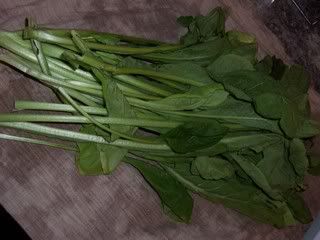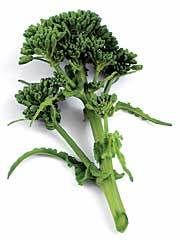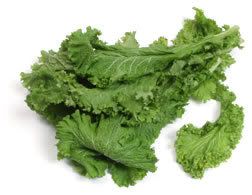This week and in coming weeks we'll have lots of greens, so this newsletter should answer your questions about working with new-to-you greens to bring delicious and nutritious meals to your family.
Why Greens?
Nutritionally speaking, cooking greens are powerhouses, especially the darker varieties. Vitamins C and E, as well as beta carotene, are found here in abundance, and these are all antioxidants, which can help prevent cancer. Remember that these benefits will be diminished the longer the greens are cooked, so it's best to cook them only until they are just tender.
How do I keep my greens fresh?
Fresh greens are crisp, without slimy dark spots.
Store greens without washing, wrapped in brown paper or a slightly dampened dishcloth or paper towel. You can then place the bundle in a plastic bag, but leave it open and then put it in a drawer in the fridge.
How do I clean greens?
- Wash greens very well to remove grit and mud. Don't wash greens until you are ready to use them.
- Prior to cleaning greens, any wilted or yellow leaves should be removed.
- Dunk them in a sink full of lukewarm water. Pull apart leaves that are bunched together. Cut away coarse stems. Peel and reserve stems of greens that have soft innards. Push floating leaves around in the water a few times. Lift the leaves from the sink and put leaves in a colander (drainer).
- Wash out the sink and fill it again. Fill with leaves, pushing them in and out the water again. Let them float briefly.
- Repeat. Never let the water drain with greens in the sink. Put greens in a colander.
How do I cook greens?
Keep in mind that greens reduce lots when cooked, so you may need to cook a larger volume than you think.
Traditionally, greens are boiled or simmered very slowly for an extended period of time until they are quite soft. This softens the texture and decreases some of their bitter flavor. Greens can also be steamed, microwaved, added to soups, salads, stews, and other dishes.
More bitter greens with tougher leaves like Mustard Greens, Kale, Collards, Swiss Chard, and Broccoli Rabe are generally cooked. Thinner, less tough greens like Mizuna can be either gently cooked in stews or stir-frys (toss in during final minutes of cooking time) or served raw as part of salads.
What's new this week?

Vitamin Greens have upright leaves that are tender and flavorful. The stem is similar to celery. Use for steaming, stir-fry and salads. Use them as you would collards or kale.

Mizuna is a Japanese mustard green with dandelion-like jagged edge green leaves with a mild, sweet and spicy earthy flavor. It has been cultivaed in Japan since ancient times, but most likely originated in China. Mizuna makes an excellent salad green, and is frequently found in Mesclun salad mixes. It is also used in stir-frys and soups.

Broccoli rabe (a.k.a. rapini) was originally cultivated in the southern Mediterranean. It looks similar to thin broccoli stalks with small clusters of buds and smooth leaves with sawtooth edges. Broccoli rabe has a somewhat bitter taste and should be cooked to help mellow that taste.

Mustard Greens are the most pungent of the cooking greens and lend a peppery flavor to food. They originated in the Himalayan region of India more than 5,000 years ago. Like many other cooking greens, mustard can be found in many Chinese, African-American, and southern dishes. Mustard greens should be cooked with the coarse stalks removed.
Quick tips for including cooking greens in your diet!
- Chop cooking greens and add to salads.
- Stir-fry greens and add beans, tofu, or tempeh and your favorite seasonings.
- Sliver greens and add them to broths, stews and soups — they are great for livening up the flavor of more mild vegetables.
- Chop cooked greens for use in stuffing.
- Combine chopped greens and pine nuts with whole grain pasta drizzled with olive oil.
- Serve greens as a side dish. They can be served chilled with olive oil and lemon juice or sautéed with onions and garlic or other seasonings.
Serves: 4
- 1 pound firm or extra-firm tofu
- 2 tablespoons olive oil
- 1 large onion, quartered and thinly sliced
- 1 good-sized bunch (about 10 to 12 ounces) spring greens, rinsed, large leaves chopped (see note)
- 1 to 2 teaspoons grated fresh ginger
- 3 tablespoons reduced-sodium soy sauce or teriyaki sauce, or to taste
- Cut the tofu into 1/2-inch-thick slices. Blot well between clean tea-towels or several layers of paper towel, then cut into 1/2-inch dice.
- Heat half of the oil in a stir-fry pan or wide skillet. Add the tofu and stir-fry over medium-high heat until golden on most sides. Remove to a plate.
- Heat the remaining oil in the same skillet. Add the onion and saute over medium heat until golden. Add the greens and ginger and stir-fry briefly, just until leaves are wilted. Stir in the tofu dice, season to taste with soy sauce, and serve at once.
Note: Use one or two Asian greens such as mizuna or tatsoi (or any other Asian greens available to you); or try a combination of spinach with arugula or watercress.
Above recipe found online at In a Vegetarian Kitchen: Spring's Leafy Greens Vitamin Greens and White Beans in Garlic Oil
- 1 bunch Vitamin Greens, washed, trimmed and chopped
- Extra-virgin olive oil
- 2 large garlic cloves, minced
- 2 cups cooked cannellini beans (or any white bean)
- 1/2 t salt
- Place the Vitamin Greens in a steamer basket set over simmering water. Cover and steam 5 minutes.
- While the greens are steaming, heat oil in a large skillet over medium heat. Add the garlic and cook 30 seconds. Stir in the beans, greens and salt. Cook until heated through. If you'd like a looser mixture, add some bean broth or stock or water.
*Basically, you can use any green for this recipe. If you want to simplify it even more, saute or braise the greens in the skillet, then add the beans.
4-6 Servings
- 1/4 cup margarine
- 1/4 cup all-purpose flour
- 2 cups vegetable stock
- 3 cups water (2 c. for a thicker soup)
- 3 medium potatoes, diced
- 3-4 broccoli rabe, florets only
- 1 cup soymilk (plain, unsweetened)
- 2 teaspoons salt (to taste)
- 1 dash garlic powder
- 1 dash onion powder
- black pepper, to taste
- 1 tablespoon Spike or other seasoning blend
- 1 dash cayenne pepper
- Melt margarine in stock pot over medium heat.
- Add onion - saute until onions are translucent.
- Stir in flour.
- Add stock, water, salt and onion/garlic powders and Spike seasoning.
- Add potato and broccoli rabe - bring back to a boil.
- Cover and simmer - stirring occasionally, until potatoes are tender.
- Using a potato masher - mash the mixture a bit, leaving some chunks. Use a hand blender for a smoother texture.
- Reduce heat to "low" and add soymilk - do not bring back to a boil.
- Add black and cayenne pepper. Adjust salt/seasonings to taste.
- Serve - garnish with grated Parmesan. (Use Soymage Vegan Parmesan for an alternative to dairy. You can find it in most health food stores.)
- 1 bunch mustard greens
- 1 tablespoon olive oil
- 2 medium shallots, chopped
- 1 tablespoon minced fresh ginger root
- 1 pinch red pepper flakes
- 1 (15 ounce) can kidney beans, drained and rinsed
- 1 (15 ounce) can tomato sauce (or 3 to4 pureed ripe tomatoes)
- 2 teaspoons curry powder
- 1/2 cup soymilk, plain unsweetened (or plain soy yogurt, for a creamier effect)
- Bring a large pot of lightly salted water to a boil. Place greens in the pot, cover, and cook 7 minutes, or just until tender. Drain, and rinse under cold water.
- Heat the olive oil in a skillet over medium-high heat, and cook the shallots until lightly brown. Stir in ginger, and season with red pepper. Mix in greens, kidney beans, tomato sauce, and curry powder. Stir in the soymilk or yogurt, and continue cooking until heated through.
If you use your CSA veggies to make something delicious, share your recipe with other members. Email the recipe and a picture (if you have one) to sugarshakes@gmail.com and we'll publish the recipe on the blog.
Bonus Earth-friendly tip:
Using less energy is a great way to help keep the planet green, but it can also save you some green. Learn how much it costs to run your household appliances with ConEd's interactive guide.

2 comments:
Italian-style Spicy Broccoli Raab!
Hands-on Time: 10 minutes
(I made this last night to big hurrahs)
Ingredients
1 BIG bunch broccoli raab--cleaned, coarsely chopped with tough stems removed (6-8 cups total)
2 cloves of garlic, crushed
2 Tablespoons olive oil
1 Tablespoon hot pepper flakes
Salt, pepper
shaves of parmesan, asiago, pecorino
Directions
1. Heat olive oil in your biggest non-stick skillet. When hot, add garlic and cook for about 30 seconds.
2. Add greens to skillet and season with salt, pepper, hot pepper flakes.
3. Using tongs, spoon, or spatula (choose your weapon) stir and flip the greens in the skillet until soft and wilted.
4. Divide onto plates and sprinkle with a few drops additional olive oil. Place a few shaves of dry italian cheese.
Super easy and delicious. These greens will have a spicy, assertive flavor that pairs well with rich foods.
Feeling fancy?
Top grilled bread with white bean paste (or hummus) and add spicy broccoli raab on top for broccoli raab crostini.
What else are people making?
Holly B. (Stuyvesant and Chauncey)
I made the curried greens using the quick cooking Chinese cabbage so I didn't have to pre-cook the greens.
Click here for picture.
Post a Comment